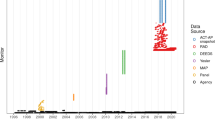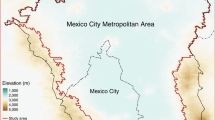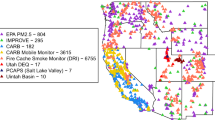Abstract
Air pollution exposure prediction models can make use of many types of air monitoring data. Fixed location passive samples typically measure concentrations averaged over several days to weeks. Mobile monitoring data can generate near continuous concentration measurements. It is not known whether mobile monitoring data are suitable for generating well-performing exposure prediction models or how they compare with other types of monitoring data in generating exposure models. Measurements from fixed site passive samplers and mobile monitoring platform were made over a 2-week period in Baltimore in the summer and winter months in 2012. Performance of exposure prediction models for long-term nitrogen oxides (NOX) and ozone (O3) concentrations were compared using a state-of-the-art approach for model development based on land use regression (LUR) and geostatistical smoothing. Model performance was evaluated using leave-one-out cross-validation (LOOCV). Models performed well using the mobile peak traffic monitoring data for both NOX and O3, with LOOCV R2s of 0.70 and 0.71, respectively, in the summer, and 0.90 and 0.58, respectively, in the winter. Models using 2-week passive samples for NOX had LOOCV R2s of 0.60 and 0.65 in the summer and winter months, respectively. The passive badge sampling data were not adequate for developing models for O3. Mobile air monitoring data can be used to successfully build well-performing LUR exposure prediction models for NOX and O3 and are a better source of data for these models than 2-week passive badge data.
This is a preview of subscription content, access via your institution
Access options
Subscribe to this journal
Receive 6 print issues and online access
$259.00 per year
only $43.17 per issue
Buy this article
- Purchase on Springer Link
- Instant access to full article PDF
Prices may be subject to local taxes which are calculated during checkout





Similar content being viewed by others
Abbreviations
- AQS:
-
Air Quality System
- LOOCV:
-
leave-one-out cross-validation
- LUR:
-
land use regression
- PLS:
-
partial least squares
- UK:
-
universal kriging
References
Hoek G, Beelen R, de Hoogh K, Vienneau D, Gulliver J, Fischer P et al. A review of land-use regression models to assess spatial variation of outdoor air pollution. Atmos Environ 2008; 42: 7561–7578.
Briggs DJ, de Hoogh C, Guiliver J, Wills J, Elliott P, Kingham S et al. A regression-based method for mapping traffic-related air pollution: application and testing in four contrasting urban environments. Sci Total Environ 2000; 253: 151–167.
Jerrett M, Burnett RT, Pope CA, 3rd, Ito K, Thurston G, Krewski D et al. Long-term ozone exposure and mortality. New Engl J Med 2009; 360: 1085–1095.
Adam-Poupart A, Brand A, Fournier M, Jerrett M, Smargiassi A . Spatiotemporal modeling of ozone levels in Quebec (Canada): a comparison of kriging, land-use regression (LUR), and combined Bayesian maximum entropy-LUR approaches. Environ Health Perspect 2014; 122: 970–976.
Hart JE, Yanosky JD, Puett RC, Ryan L, Dockery DW, Smith TJ et al. Spatial modeling of PM10 and NO2 in the continental United States, 1985-2000. Environ Health Perspect 2009; 117: 1690–1696.
Madsen C, Carlsen KCL, Hoek G, Oftedal B, Nafstad P, Meliefste K et al. Modeling the intra-urban variability of outdoor traffic pollution in Oslo, Norway - A GA(2)LEN project. Atmos Environ 2007; 41: 7500–7511.
Ross Z, English PB, Scalf R, Gunier R, Smorodinsky S, Wall S et al. Nitrogen dioxide prediction in Southern California using land use regression modeling: potential for environmental health analyses. J Expo Sci Env Epid 2006; 16: 106–114.
Gonzales M, Qualls C, Hudgens E, Neas L . Characterization of a spatial gradient of nitrogen dioxide across a United States-Mexico border city during winter. Sci Total Environ 2005; 337: 163–173.
Brunekreef B . Exposure science, the exposome, and public health. Environ Mol Mutagen 2013; 54: 596–598.
Beelen R, Hoek G, Vienneau D, Eeftens M, Dimakopoulou K, Pedeli X et al. Development of NO2 and NOx land use regression models for estimating air pollution exposure in 36 study areas in Europe - The ESCAPE project. Atmos Environ 2013; 72: 10–23.
Kanaroglou PS, Jerrett M, Morrison J, Beckerman B, Arain MA, Gilbert NL et al. Establishing an air pollution monitoring network for intra-urban population exposure assessment: A location-allocation approach. Atmos Environ 2005; 39: 2399–2409.
Padro-Martinez LT, Patton AP, Trull JB, Zamore W, Brugge D, Durant JL . Mobile monitoring of particle number concentration and other traffic-related air pollutants in a near-highway neighborhood over the course of a year. Atmos Environ 2012; 61: 253–264.
Norris G, Larson T . Spatial and temporal measurements of NO2 in an urban area using continuous mobile monitoring and passive samplers. J Expos Sci Anal Environ Epidemiol 1999; 9: 586–593.
Larson T, Henderson SB, Brauer M . Mobile monitoring of particle light absorption coefficient in an urban area as a basis for land use regression. Environ Sci Technol 2009; 43: 4672–4678.
Larson T, Garcia N, Covert D, Brauer M . Mobile monitoring of particulate black carbon concentrations in an urban area. Epidemiology 2006; 17: 479–479.
Montagne D, Hoek G, Nieuwenhuijsen M, Lanki T, Pennanen A, Portella M et al. The association of LUR modeled PM2.5 elemental composition with personal exposure. Sci Total Environ 2014; 493: 298–306.
Khoder MI . Diurnal, seasonal and weekdays–weekends variations of ground level ozone concentrations in an urban area in greater Cairo. Environ Monit Assess 2009; 149: 349–362.
Reddy BSK, Kumar KR, Balakrishnaiah G, Gopal KR, Reddy RR, Ahammed YN et al. Observational studies on the variations in surface ozone concentration at Anantapur in southern India. Atmos Res 2010; 98: 125–139.
Riley EA, Banks L, Fintzi J, Gould TR, Hartin K, Schaal L et al. Multi-pollutant mobile platform measurements of air pollutants adjacent to a major roadway. Atmos Environ 2014; 98: 492–499.
National Geospatial Intelligence Agency. Ports of the Wider Caribbean, from NIMA World Port Index. Available: https://www.nga.mil/Pages/Default.aspx; 2013.
National Land Cover Database. NLCD 2006 Land Cover (2011 Edition). Available: http://www.mrlc.gov/nlcd2006.php; 2006.
Global Land Cover Facility. MODIS Normalized Difference Vegetation Index. Available: http://glcf.umd.edu/data/ndvi/; 2006.
U.S. Geological Survey. National Elevation Dataset. Available: http://nationalmap.gov/elevation.html; 2013.
U.S. EPA (U.S. Environmental Protection Agency). Emission Inventory Group. Available: http://www.epa.gov/air/emissions; 2006.
Sampson PD, Richards M, Szpiro AA, Bergen S, Sheppard L, Larson TV et al. A regionalized national universal kriging model using Partial Least Squares regression for estimating annual PM2.5 concentrations in epidemiology. Atmos Environ 2013; 75: 383–392.
Mevik B-H WR, Liland KH, pls: Partial Least Squares and Principal Component regression. R package version 23-0 2011.
Brantley HL, Hagler GSW, Kimbrough ES, Williams RW, Mukerjee S, Neas LM . Mobile air monitoring data-processing strategies and effects on spatial air pollution trends. Atmos Meas Tech 2014; 7: 2169–2183.
Bergen S, Sheppard L, Sampson PD, Kim SY, Richards M, Vedal S et al. A national prediction model for PM2.5 component exposures and measurement error-corrected health effect inference. Environ Health Perspect 2013; 121: 1017–1025.
Mercer LD, Szpiro AA, Sheppard L, Lindstrom J, Adar SD, Allen RW et al. Comparing universal kriging and land-use regression for predicting concentrations of gaseous oxides of nitrogen (NOx) for the Multi-Ethnic Study of Atherosclerosis and Air Pollution (MESA Air). Atmos Environ 2011; 45: 4412–4420.
Keller JP, Olives C, Kim SY, Sheppard L, Sampson PD, Szpiro AA et al. A unified spatiotemporal modeling approach for predicting concentrations of multiple air pollutants in the Multi-Ethnic Study of Atherosclerosis and Air Pollution. Environ Health Perspect 2014; 123: 301–309.
Baxter LK, Dionisio KL, Burke J, Sarnat SE, Sarnat JA, Hodas N et al. Exposure prediction approaches used in air pollution epidemiology studies: key findings and future recommendations. J Expo Sci Env Epid 2013; 23: 654–659.
Liu LJS, Rossini AJ . Use of kriging models to predict 12-hour mean ozone concentrations in metropolitan Toronto - A pilot study. Environ Int 1996; 22: 677–692.
Araki SYK, Kondo A . Application of regression kriging to air pollutants concentrations in Japan with high spatial resolution. Aerosol Air Qual Res 2015; 15: 234–24.
Acknowledgements
Wei Xu was supported by a scholarship awarded by the Chinese Scholarship Council. This publication was made possible by USEPA grant (RD-83479601-0). Its contents are solely the responsibility of the grantee and do not necessarily represent the official views of the USEPA. Further, USEPA does not endorse the purchase of any commercial products or services mentioned in the publication.
Author information
Authors and Affiliations
Corresponding author
Ethics declarations
Competing interests
The authors declare no conflict of interest.
Additional information
Supplementary Information accompanies the paper on the Journal of Exposure Science and Environmental Epidemiology website
Supplementary information
Rights and permissions
About this article
Cite this article
Xu, W., Riley, E., Austin, E. et al. Use of mobile and passive badge air monitoring data for NOX and ozone air pollution spatial exposure prediction models. J Expo Sci Environ Epidemiol 27, 184–192 (2017). https://doi.org/10.1038/jes.2016.9
Received:
Accepted:
Published:
Issue Date:
DOI: https://doi.org/10.1038/jes.2016.9
Keywords
This article is cited by
-
Characterization of Non-Conventional Airborne Pollutants (BTEX) by means of Chemometric Techniques
Environmental Modeling & Assessment (2024)
-
Ozone Concentration Forecasting Based on Artificial Intelligence Techniques: A Systematic Review
Water, Air, & Soil Pollution (2021)
-
High-resolution mapping of traffic related air pollution with Google street view cars and incidence of cardiovascular events within neighborhoods in Oakland, CA
Environmental Health (2018)



